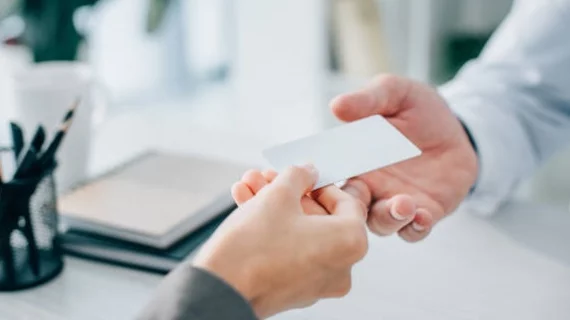Patients frequently cannot remember the name of a radiologist following breast imaging, possibly fueled by the stress of the encounter. But the simple act of handing out a business card may go a long way in curing this forgetfulness.
Researchers at two European imaging centers recently tested out this theory, with eye-opening results. About 85% of patients—who received the card following mammography and ultrasound exams—remembered the radiologist’s name when contacted days later. That’s compared to just 7% of those who experienced the exact same scenario, minus the business card, researchers reported Feb. 13 in Cancer Imaging.
Such a simple change in practice could prove to be a game-changer for radiologists hoping to leave the reading room and deliver more patient-centered care, the authors argued.
“Using business cards significantly increased the recall of the radiologist’s name and could be an important tool in improving the relationships between patients and radiologists and enhancing service professionalism,” concluded the team, led by Andreas Gutzeit, a radiologist with Paracelsus Medical University in Salzburg, Austria.
To test their theory, Gutzeit and fellow radiologist Matthias Meissnitzer targeted 140 women with BI-RADS 1 and 2 scores who received breast imaging at two centers in Switzerland and Austria. Each received the exact same course of care, with appointments timed to ensure equal duration. After sharing that the test results were “unremarkable” at both centers and bidding goodbye, half of the study population got a business card while the rest did not.
The research team then phoned subjects within one week following the exam to administer an eight-question survey about the appointment. Others were excluded if a tumor showed up in imaging or a patient refused to participate in the survey, they noted.
About 90% of those who received the business card believed that it was “very important” to be able to contact the radiologist at a later date, compared to 76% in the other group. And about 87% who received the card said they’d contact the physician with questions, versus 73% of their counterparts. Interestingly, zero patients ever actually contacted radiologists following the exam—a counterargument for those who are concerned about receiving dozens of phone calls.
There was no difference between the two groups of patients’ perceived competence of the radiologists. And 100% of subjects in both groups said they’d recommend the radiology department to others.
Some radiologists may wish to remain “pure imagers” who stick solely to interpretation duties, given the fast-paced demands and heavy workload in care delivery today, the team noted. But Gutzeit and colleagues believe their results demonstrate that patients have a clear interest in forming closer bonds with imaging physicians. The proliferation of artificial intelligence, they added, is only going to make it more important to engage with healthcare consumers.
“We believe that radiologists need to show patients more what the value of a good radiology service is and that patients should perceive radiologists as unique experts,” Gutzeit et al. wrote. “If we assume that machines will soon be better than radiologists, there is only one route left to us: We should not behave like machines, but become empathic doctors who are responsive to our patients’ needs before, during and after their examinations—something which patients would highly value.”

